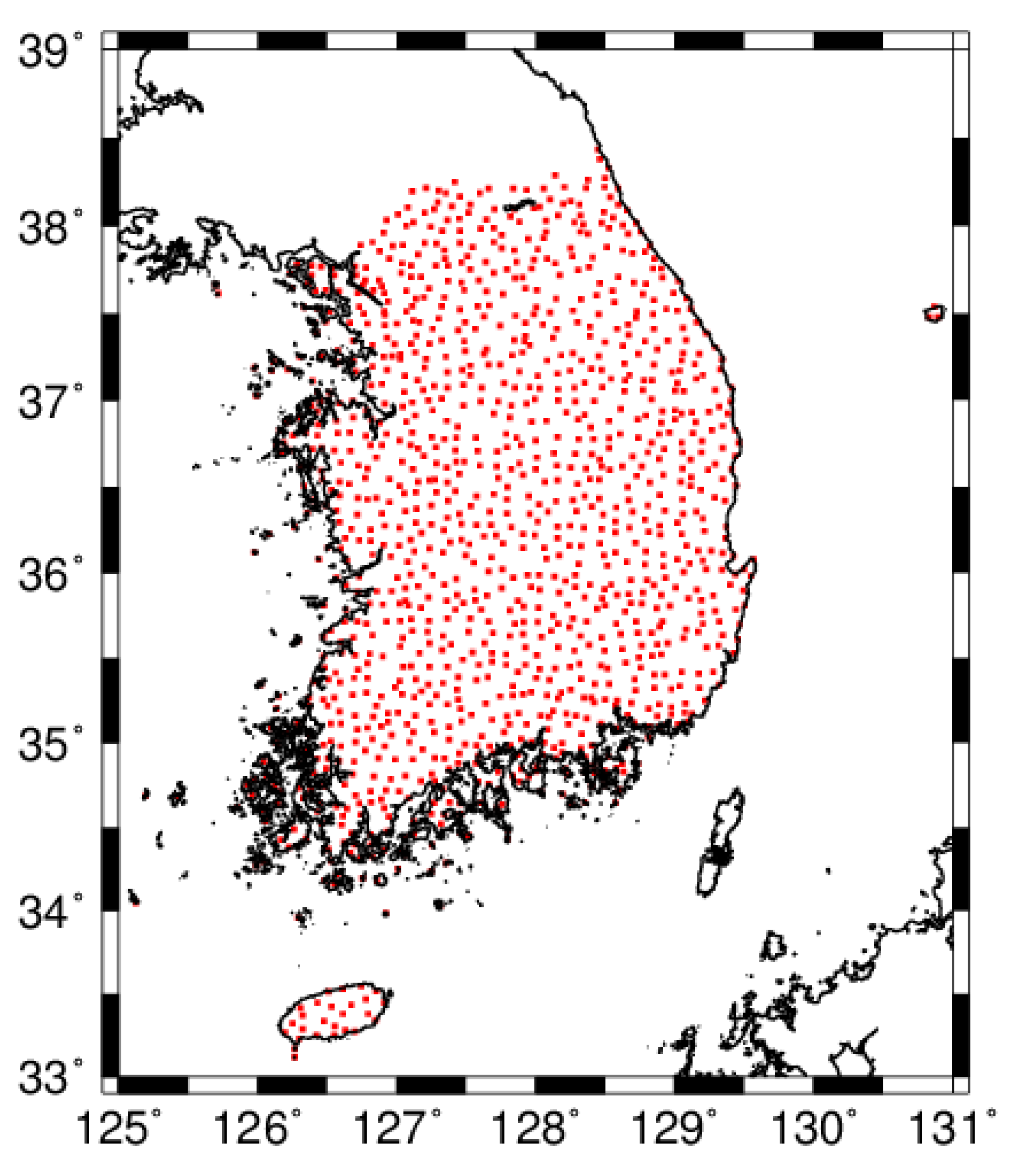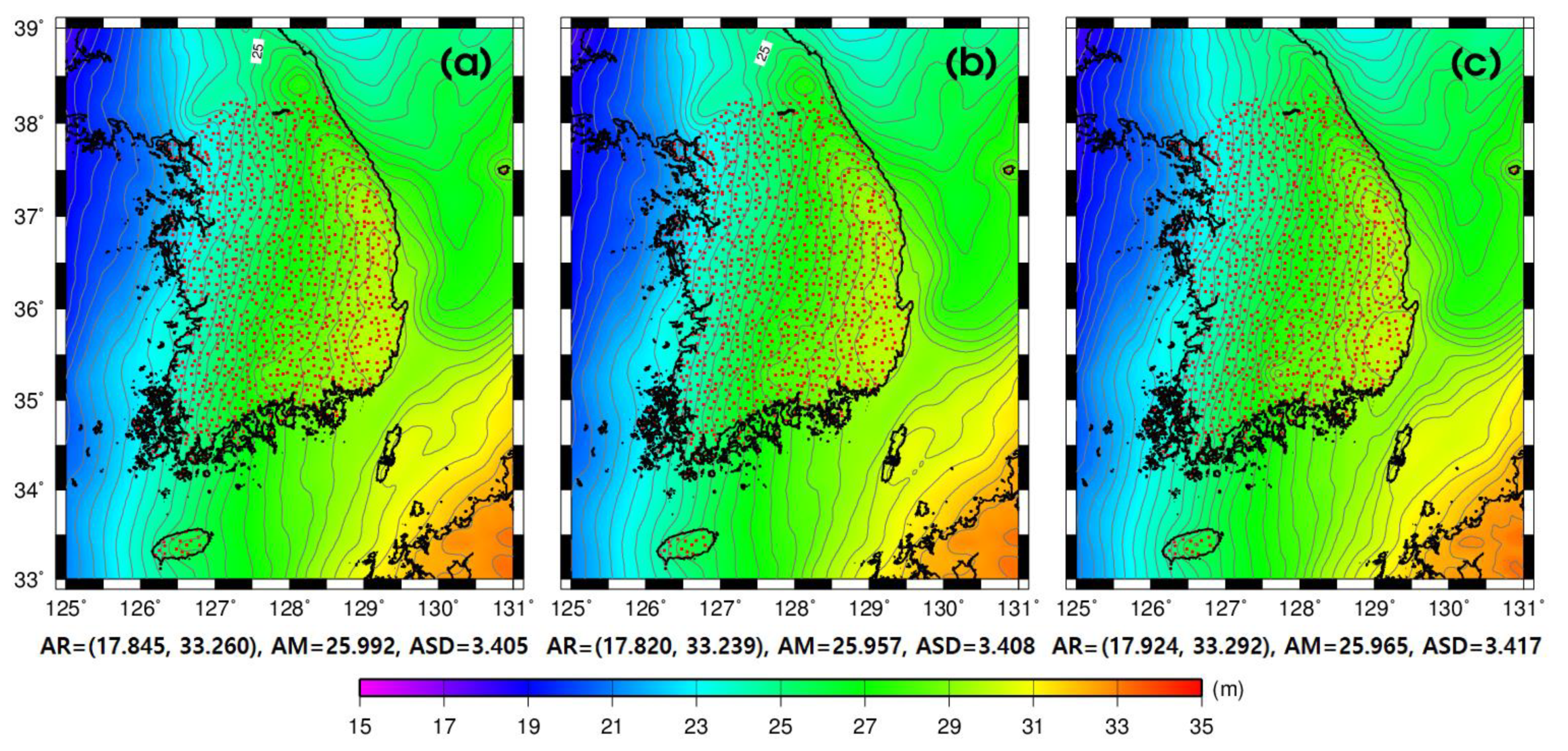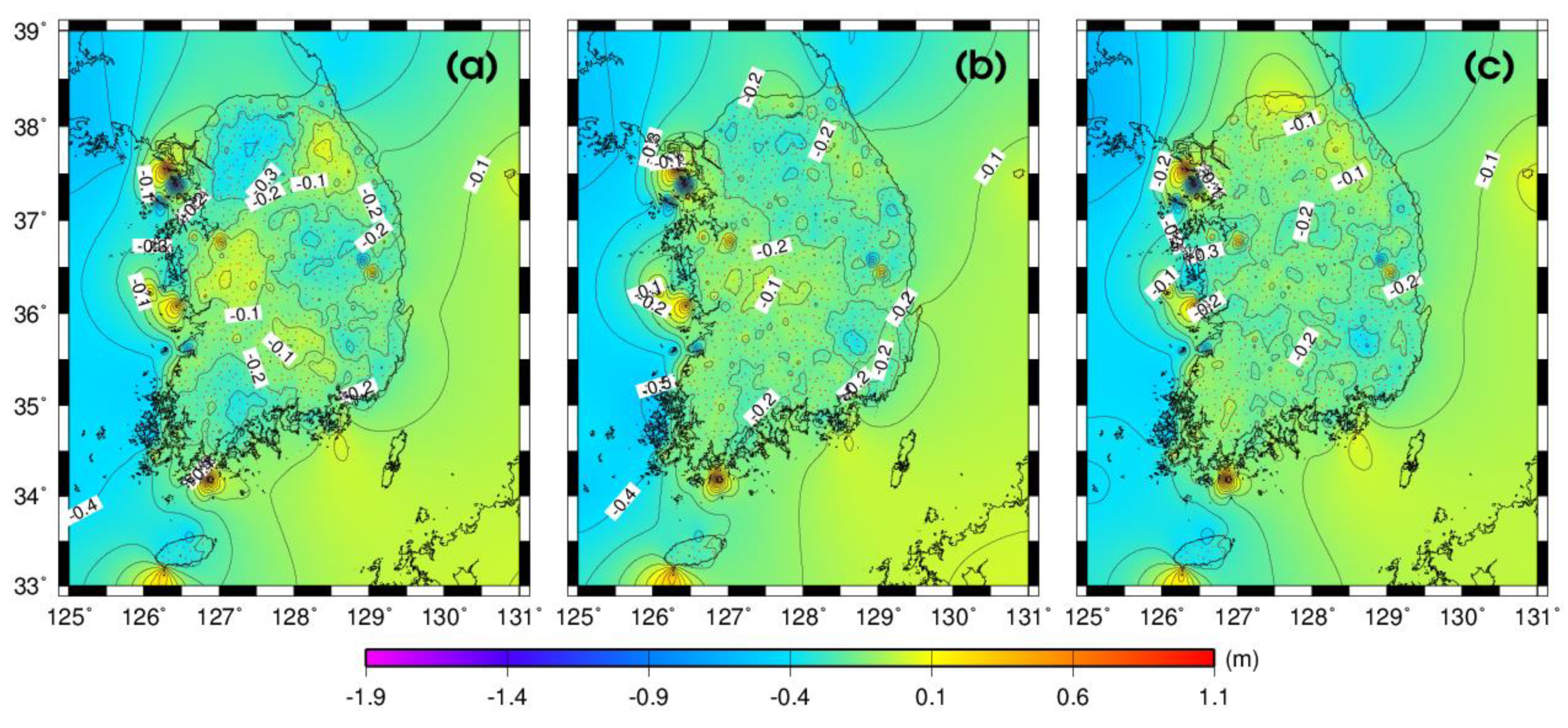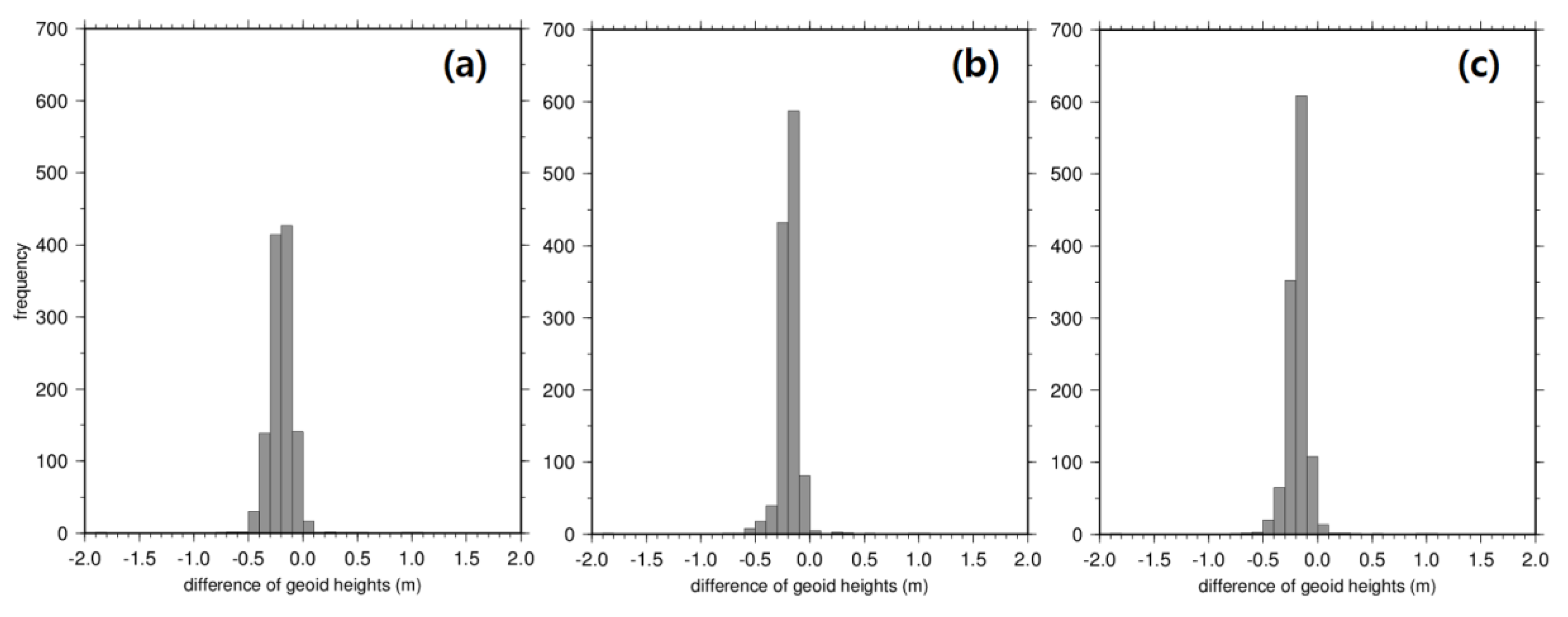Accuracy Evaluation of Geoid Heights in the National Control Points of South Korea Using High-Degree Geopotential Model
Abstract
1. Introduction
2. Materials and Methods
2.1. Study Area
2.2. Geoid Height Computation from GGMs
3. Results and Discussions
4. Conclusions
Author Contributions
Funding
Conflicts of Interest
References
- Lemoine, F.G.; Kenyon, S.C.; Factor, J.K.; Trimmer, R.G.; Pavlis, N.K.; Chinn, D.S.; Cox, C.M.; Klosko, S.M.; Luthcke, S.B.; Torrence, M.H.; et al. The Development of the Joint NASA GSFC and the National Imagery and Mapping Agency (NIMA) Geopotential Model EGM96; NASA Technical Paper; NASA/TP1998206 861; Goddard Space Flight Center: Greenbelt, MD, USA, 1998. [Google Scholar]
- Reigber, C.; Schwintzer, P.; Stubenvoll, R.; Schmidt, R.; Flechtner, F.; Meyer, U.; König, R.; Neumayer, H.; Förste, C.; Barthelmes, F.; et al. A High Resolution Global Gravity Field Model Combining CHAMP and GRACE Satellite Mission and Surface Data: EIGEN-CG01C; Scientific Technical Report STR06/07l; GeoForschungsZentrum (GFZ): Potsdam, Germany, 2006. [Google Scholar]
- Förste, C.; Flechtner, F.; Schmidt, R.; Meyer, U.; Stubenvoll, R.; Barthelmes, F.; Rothacher, M.; Biancale, R.; Bruinsma, S.; Lemoine, J.-M. A new high resolution global gravity field model from the combination of GRACE satellite mission and altimetry/gravimetry sur-face gravity data. In Proceedings of the EGU General Assembly, Vienna, Austria, 24–29 April 2005. [Google Scholar]
- Pavlis, N.K.; Holmes, S.A.; Kenyon, S.C.; Factor, J.K. The development and evaluation of the Earth Gravitational Model 2008 (EGM2008). J. Geophys. Res. 2012, 117, B04406. [Google Scholar] [CrossRef]
- Lee, S.B.; Lee, D.H. Evaluation of the topographic effect using the various gravity reduction methods for precise geoid model in Korea. In Proceedings of International Association of Geodesy Symposia, Crete, Greece, 23–27 June 2010; pp. 273–281. [Google Scholar]
- Lee, S.B.; Kim, C.Y. Development of regional gravimetric geoid model and comparison with EGM2008 gravity-field model over Korea. Sci. Res. Essays 2012, 7, 387–397. [Google Scholar]
- Baek, K.; Kwon, J.H.; Lee, J. Precision verification of new global gravitational model using GPS/leveling data. J. Kor. Soc. Surv. Geodesy Photogramm. Cartogr. 2013, 31, 239–247. [Google Scholar] [CrossRef][Green Version]
- Lee, S.B.; Auh, S.C.; Seo, D.Y. Evaluation of global and regional geoid models in South Korea by using terrestrial and GNSS data. KSCE J. Civ. Eng. 2017, 21, 1905–1911. [Google Scholar] [CrossRef]
- Lee, S.B. Determination of precise regional geoid heights on and around mount Jiri, South Korea. J. Kor. Soc. Surv. Geodesy Photogramm. Cartogr. 2018, 36, 9–15. [Google Scholar]
- Drinkwater, M.R.; Floberghagen, R.; Haagmans, R.; Muzi, D.; Popescu, A. GOCE: ESA’s first Earth Explorer Core mission. In Earth Gravity Field from Space—From Sensors to Earth Sciences; Beutler, G., Drinkwater, M.R., Rummel, R., von Steiger, R., Eds.; Space Sciences Series of ISSI; Springer: Dordrecht, The Netherlands, 2003; Volume 17, pp. 419–432. [Google Scholar]
- Tapley, B.D.; Bettadpur, S.; Watkins, M.; Reigber, C. The gravity recovery and climate experiment: Mission overview and early results. Geophys. Res. Lett. 2004, 31, L09607. [Google Scholar] [CrossRef]
- Andersen, O.B. The DTU10 gravity field and mean sea surface. In Proceedings of the Second International Symposium of the International Gravity Field Service, Gravity Field of the Earth (IGFS2). Fairbanks, AK, USA, 20–22 September 2010. [Google Scholar]
- Baek, K.; Lee, J.; Shin, K.; Kwon, J.H.; Moon, J. Construction and precision verification of Korean national geoid model KNGeoid13. In Proceedings of the 2014 Conference of the Korean Society of Surveying, Geodesy, Photogrammetry, and Cartography, Seoul, Korea, 24–25 April 2014; pp. 111–114. [Google Scholar]
- Lee, J.; Kwon, J.H. Construction and precision verification of Korean national geoid model KNGeoid14. In Proceedings of the 2015 Conference of the Korean Society of Surveying, Geodesy, Photogrammetry, and Cartography, Masan, Korea, 23–24 April 2015; pp. 177–179. [Google Scholar]
- Pail, R.l.; Fecher, T.; Barnes, D.; Factor, J.F.; Holmes, S.A.; Gruber, T.; Zingerle, P. Short note: The experimental geopotential model XGM2016. J. Geod. 2018, 42, 443–451. [Google Scholar] [CrossRef]
- NGII. Establishment of National Geoid Model and Linked Model of Vertical Datum in Land and Marine; NGII Report; Publication No. 11-1613436-000166-01; National Geographic Information Institute: Suwon, Korea, 2018. [Google Scholar]
- Förste, C.; Bruinsma, S.L.; Abrikosov, O.; Lemoine, J.-M.; Marty, J.C.; Flechtner, F.; Balmino, G.; Barthelmes, F.; Biancale, R. EIGEN-6C4 The latest combined global gravity field model including GOCE data up to degree and order 2190 of GFZ Potsdam and GRGS Toulouse. GFZ Data Serv. 2015. [Google Scholar] [CrossRef]
- Gilardoni, M.; Reguzzoni, M.; Sampietro, D. GECO: A global gravity model by locally combining GOCE data and EGM2008. Stud. Geophys. Geod. 2016, 60, 228–247. [Google Scholar] [CrossRef]
- Ince, E.S.; Barthelmes, F.; Reißland, S.; Elger, K.; Förste, C.; Flechtner, F.; Schuh, H. ICGEM—15 years of successful collection and distribution of global gravitational models, associated services, and future plans. Earth Syst. Sci. Data 2019, 11, 647–674. [Google Scholar] [CrossRef]
- Heiskanen, W.A.; Moritz, H. Physical Geodesy; W.H. Freeman: San Francisco, CA, USA, 1967. [Google Scholar]
- Fotopoulos, G. An Analysis on the Optimal Combination of Geoid, Orthometric and Ellipsoidal Height Data. Ph.D. Thesis, University of Calgary, Calgary Canada, December 2003. [Google Scholar]
- Kiamehr, R.; Sjöberg, L.E. Comparison of the qualities of recent global and local gravimetric geoid models in Iran. Stud. Geophys. Geod. 2005, 49, 289–304. [Google Scholar] [CrossRef]
- Kotsakis, C.; Sideris, M.G. On the adjustment of combined GPS/levelling/geoid networks. J. Geod. 1999, 73, 412–421. [Google Scholar] [CrossRef]
- Fotopoulos, G. Combination of Heights. In Geoid Determination: Theory and Methods; Sanso, F., Sideris, M.G., Eds.; Lecture Notes in Earth System Science; SpringerLink: Berlin/Heidelberg, Germany, 2013; pp. 517–544. [Google Scholar]
- Wessel, P.; Smith, W.H.F.; Scharroo, R.; Luis, J.; Wobbe, F. Generic mapping tools: Improved version released. EOS Trans. Am. Geophys. Union 2013, 94, 409–410. [Google Scholar] [CrossRef]







| Country/Region | GNSS/Leveling Data Points | Global Geopotential Models (Nmax) | ||
|---|---|---|---|---|
| EGM2008 (2190) | EIGEN-6C4 (2190) | GECO (2190) | ||
| Australia | 201 | 21.7 cm | 21.2 cm | 21.6 cm |
| Brazil | 1112 | 46.0 cm | 44.6 cm | 45.1 cm |
| Canada | 2691 | 12.8 cm | 12.6 cm | 13.1 cm |
| Europe | 1047 | 12.5 cm | 12.1 cm | 12.3 cm |
| Japan | 816 | 8.3 cm | 7.9 cm | 8.0 cm |
| USA | 6169 | 24.8 cm | 24.7 cm | 24.6 cm |
| All | 12,036 | 23.97 cm | 23.61 cm | 23.71 cm |
| Geopotential Model | Year | Max. Degree | Data Type |
|---|---|---|---|
| GECO | 2016 | 2190 | S (GOCE), EGM2008 |
| EIGEN-6C4 | 2014 | 2190 | S (GOCE, GRACE, LAGEOS), A, G |
| EGM2008 | 2008 | 2190 | S (GRACE), A, G |
| Min. | Max. | Mean | Std. Dev. | RMSE | |
|---|---|---|---|---|---|
| −1.837 | 1.025 | −0.199 | 0.126 | 0.236 | |
| −1.817 | 1.010 | −0.191 | 0.112 | 0.221 | |
| −1.801 | 1.012 | −0.184 | 0.113 | 0.216 |
| Model | ≤0.05 m | ≤0.10 m | ≤0.20 m | ≤0.30 m | ≤0.40 m | ≤0.50 m |
|---|---|---|---|---|---|---|
| GECO | 71 (6.0%) | 158 (13.4%) | 587 (49.7%) | 1003 (84.9%) | 1142 (96.6%) | 1173 (99.2%) |
| EIGEN-6C4 | 25 (2.1%) | 86 (7.3%) | 673 (56.9%) | 1108 (93.7%) | 1150 (97.3%) | 1168 (98.8%) |
| EGM2008 | 40 (3.4%) | 122 (10.3%) | 733 (62.0%) | 1086 (91.9%) | 1152 (97.5%) | 1172 (99.1%) |
| Min. | Max. | Mean | Std. dev. | RMSE | |
|---|---|---|---|---|---|
| −1.749 | 1.061 | −0.033 | 0.107 | 0.112 | |
| −1.707 | 1.097 | −0.001 | 0.106 | 0.106 | |
| −1.770 | 1.066 | −0.015 | 0.102 | 0.103 |
| Model | ≤0.02 m | ≤0.05 m | ≤0.10 m | ≤0.15 m | ≤0.20 m | ≤0.50 m |
|---|---|---|---|---|---|---|
| KNGeoid13 | 352 (29.8%) | 764 (64.6%) | 1047 (88.6%) | 1107 (93.7%) | 1128 (95.4%) | 1174 (99.3%) |
| KNGeoid14 | 471 (39.8%) | 899 (76.1%) | 1079 (91.3%) | 1119 (94.7%) | 1133 (95.9%) | 1173 (99.2%) |
| KNGeoid18 | 549 (46.4%) | 950 (80.4%) | 1108 (93.7%) | 1131 (95.7%) | 1141 (96.5%) | 1173 (99.2%) |
© 2020 by the authors. Licensee MDPI, Basel, Switzerland. This article is an open access article distributed under the terms and conditions of the Creative Commons Attribution (CC BY) license (http://creativecommons.org/licenses/by/4.0/).
Share and Cite
Kim, K.B.; Yun, H.S.; Choi, H.J. Accuracy Evaluation of Geoid Heights in the National Control Points of South Korea Using High-Degree Geopotential Model. Appl. Sci. 2020, 10, 1466. https://doi.org/10.3390/app10041466
Kim KB, Yun HS, Choi HJ. Accuracy Evaluation of Geoid Heights in the National Control Points of South Korea Using High-Degree Geopotential Model. Applied Sciences. 2020; 10(4):1466. https://doi.org/10.3390/app10041466
Chicago/Turabian StyleKim, Kwang Bae, Hong Sik Yun, and Ha Jung Choi. 2020. "Accuracy Evaluation of Geoid Heights in the National Control Points of South Korea Using High-Degree Geopotential Model" Applied Sciences 10, no. 4: 1466. https://doi.org/10.3390/app10041466
APA StyleKim, K. B., Yun, H. S., & Choi, H. J. (2020). Accuracy Evaluation of Geoid Heights in the National Control Points of South Korea Using High-Degree Geopotential Model. Applied Sciences, 10(4), 1466. https://doi.org/10.3390/app10041466





